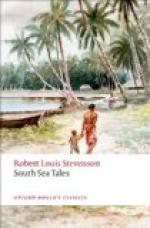Yet a few years ago, and the people of the archipelago were crafty savages. Their isles might be called sirens’ isles, not merely from the attraction they exerted on the passing mariner, but from the perils that awaited him on shore. Even to this day, in certain outlying islands, danger lingers; and the civilized Paumotuan dreads to land and hesitates to accost his backward brother. But, except in these, to-day the peril is a memory. When our generation were yet in the cradle and playroom it was still a living fact. Between 1830 and 1840, Hao, for instance, was a place of the most dangerous approach, where ships were seized and crews kidnapped. As late as 1856, the schooner Sarah Ann sailed from Papeete and was seen no more. She had women on board, and children, the captain’s wife, a nursemaid, a baby, and the two young sons of a Captain Steven on their way to the mainland for schooling. All were supposed to have perished in a squall. A year later, the captain of the Julia, coasting along the island variously called Bligh, Lagoon, and Tematangi saw armed natives follow the course of his schooner, clad in many-coloured stuffs. Suspicion was at once aroused; the mother of the lost children was profuse of money; and one expedition having found the place deserted, and returned content with firing a few shots, she raised and herself accompanied another. None appeared to greet or to oppose them; they roamed a while among abandoned huts and empty thickets; then formed two parties and set forth to beat, from end to end, the pandanus jungle of the island. One man remained alone by the landing-place—Teina, a chief of Anaa, leader of the armed natives who made the strength of the expedition. Now that his comrades were departed this way and that, on their laborious exploration, the silence fell profound; and this silence was the ruin of the islanders. A sound of stones rattling caught the ear of Teina. He looked, thinking to perceive a crab, and saw instead the brown hand of a human being issue from a fissure in the ground. A shout recalled the search parties and announced their doom to the buried caitiffs. In the cave below, sixteen were found crouching among human bones and singular and horrid curiosities. One was a head of golden hair, supposed to be a relic of the captain’s wife; another was half of the body of a European child, sun-dried and stuck upon a stick, doubtless with some design of wizardry.
The Paumotuan is eager to be rich. He saves, grudges, buries money, fears not work. For a dollar each, two natives passed the hours of daylight cleaning our ship’s copper. It was strange to see them so indefatigable and so much at ease in the water—working at times with their pipes lighted, the smoker at times submerged and only the glowing bowl above the surface; it was stranger still to think they were next congeners to the incapable Marquesan. But the Paumotuan not only saves, grudges, and works, he steals besides; or, to be more




